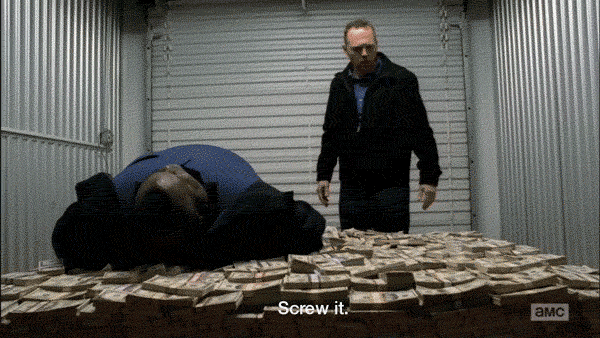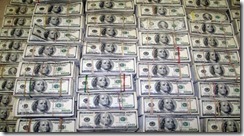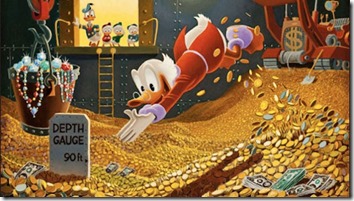Oh, hey there. We have to stop meeting like this.
We don’t meet. We’re the same person. I just hit Ctrl-B and I’m you.
So I’m Tyler Durden, and you’re… Robert Paulson? No, that was Meat Loaf. Wait, Edward Norton didn’t have a name in that movie, did he? Huh. I guess I never realized that.
And neither of us knows Helena Bonham-Carter. But watching Michigan football these days is like punching yourself in the face in a parking lot, so I guess that works.
I’ll be over here making soap if you need anything
Anywho, the O’Bannon trial ended last Friday, and it’s time to poke the corpse with a stick for a while. Many people spent the weeks and months up to the trial saying that the NCAA was probably screwed. Many of those same people spent the three weeks of the trial declaring that the NCAA was DEFINITELY screwed (and mocking them at every turn). And then came the last day of the trial, in which the plaintiffs had a bad day and some people declared that the NCAA was only mostly dead. So, to clear things up, I’ll make the following nuanced legal prediction:
The NCAA remains deeply and profoundly screwed. I think.
We shall delve into the ways, and the likely outcomes, but if you don’t want to read beyond the impending blather and the jump and the more blather, you may enjoy this Fourth of July weekend comfortable in the knowledge that Mark Emmert will, in short order, have a sad.
So why did everyone say the NCAA might not have to go on the cart?
Well, the thing about anti-trust law…
[returns to rendering fat]
…is that it isn’t the remedy for all ills caused by gigantic douchey monoliths. The plaintiff (O’Bannon) has the burden of showing violations of antitrust law, not just terrible behavior; the NCAA could have burned the entire 1995 UCLA Bruins basketball at the stake and it wouldn’t be an antitrust violation. As sports law and antitrust guru Michael McCann put it, antitrust law is “about protecting competition in the marketplace for the benefit of consumers and marketplace participants.” O’Bannon has to point to a specific defined market that the NCAA is harming, and to identify who the buyers are and who the sellers are in the market, as well as the specific harm created to consumers or market participants. If you can’t figure out how that works when we’re talking about college sports, you’re in the company of at least one federal judge.
The plaintiffs struggled to articulate these things at the weird closing argument Q&A the judge did, because it doesn’t really map to college football very well. But while it is understandable, if O’Bannon can’t explain how the NCAA is harming consumers in a specific market, the NCAA could skate.
[AFTER THE JUMP: NSFMBF]
So you’re saying the NCAA might actually WIN this clown show?
Not so fast my bolded friend. The plaintiffs put all of the pieces of an antitrust violation into the record, and they still get to submit a final brief to tie it all together. They can also throw a few theories out there, and as long as something sticks, the plaintiffs are in business. As McCann points out, there is a decent argument in the rubble of these three weeks:
Watch for O’Bannon’s lawyers to simplify their argument in forthcoming filings. They will likely define the relevant market in a straightforward way: Colleges are the buyers and prospective and current student-athletes are the sellers. Through this lens, athletes sell their athletic services to colleges but are denied compensation for the commercial use of their names, images and likenesses. The denial arises because of amateurism rules, which allegedly reveal collusion by the NCAA and its member institutions.
And given how one-sided the trial was generally, any colorable theory will probably be good enough. My guess is that the transcript from economist Roger Noll will probably have more than enough by itself.
What about all of those arguments you claimed the NCAA had? Did any of them stick?
Yeah, notsomuch. As we discussed, the NCAA put forth several theories of about how their rules provided a net positive; that they provided more benefit to the athletes than they did harm. Those arguments played out very not well for The Man. The four arguments were as follows:
1) Competitive balance: The current NCAA structure fosters a competitive balance that would be significantly altered by the elimination of these restrictions, to the detriment of the athletes.
Sure, in the abstract, Middle Tennessee State is operating under the same rules as Alabama, and that they are therefore theoretically on equal footing. But you the plaintiffs didn’t have to dig too deep to prove that this was… uh… not remotely true. Several plaintiff witnesses (especially Roger Noll, who was worth his weight in gold) provided evidence that there is no competitive balance. A ‘fair’ fight is not the same as a competitive fight. You can’t put Tyson in the ring with a 3rd grader, lay down some ground rules, and expect a healthy competition. The numbers bear that out; in both football and men’s basketball, top recruits ALL choose FBS schools, and the vast, vast majority of them choose schools in power conferences. A small subset of teams always comprises the Top 25, an even smaller subset always comprises the Top 10, and an even smaller subset of the subset comprises the Top 1.
Sure, if Big Ten teams decide they can pay players, and Sun Belt teams don’t, Sun Belt teams will probably be at an even greater disadvantage. But how is this any different than the current regime? Teams face these kinds of keeping-up-with-the-Joneses pressures anyway. Wanna compete with Bama and Michigan and Texas? You’d better pour some serious resources into recruiting, facilities, coaches, and unlimited snacks. And despite the fact that those pressures have grown stronger, teams keep trying to join the highest echelons, not flee them.
This was a constant refrain from the plaintiffs: the college football industry does not show the hallmarks of a struggling industry that can’t afford to pay players. Rising salaries, participants trying hard to get INTO the market, and significant capital investments aren’t the kinds of things you expect to see in a struggling industry.
2) Integration with the University: The current NCAA structure helps to facilitate the integration of academics and athletics in student life, and it provides for more competition for athletes, and eliminating NCAA restrictions would destroy that integration.
This has been tricky for both sides, because they’ve had to argue in anecdotal evidence. The plaintiffs try to paint a picture of athletics as a full-time job in which kids are athletes first and students second. They also tried to argue that it sets students apart from mere mortals; they introduced plenty of evidence, pointing out several athletes-only dorms and other athletic support facilities. The parties argued whether athletes take the same classes and majors, or if some of the “classes” and “majors” were specifically designed to get around the whole “college” aspect of college athletics.* Some of the dumbest pieces of evidence have come out of this topic. The NCAA pointed out the fact that a player tweeted about watching television, because if he has time to watch TV he’s just a regular student with down-time to be all normal and stuff.
The NCAA’s problem was that they introduced NO evidence that players receiving money will somehow make them less integrated into college life and academics, or that there is any benefit to competition from the purported integration. Their attempts to do so haven’t been very effective from a legal standpoint, and have been disastrous from a PR standpoint. NCAA witnesses pontificated about the importance of players playing for school pride and “love of the game," and how playing for a paycheck would be different, but in what can only be a news flash to the NCAA, EVERYONE GOES TO COLLEGE FOR MONEY. No one gets an engineering degree because they love circuits.
Judge Wilken determined before the trial that the NCAA “must present evidence to show that (1) the ban on student-athlete compensation actually contributes to the integration of education and athletics and (2) the integration of education and athletics enhances competition” among the universities for football and men's basketball players. I don’t think they did either part, at least not well.
[*North Carolina, we’re looking in your direction. And we just received 3 credits in “Looking in North Carolina’s Direction 101,” which is a pre-requisite to that coveted Visual Acuity major.]
3) Amateurism is vital: Amateurism is a key component of college sports, and the current NCAA model reflects and provides for that “amateurism” in a way that would be materially degraded if these rules were eliminated or weakened.
Possibly the crux of the whole dealy. The NCAA has argued that no one will watch college football if players get paid. It’ll blend into the background of other sports, because it will lose its unique cache. To support this point, the NCAA introduced public opinion surveys in which people said they don’t want players to get paid, and that players getting paid would affect their interest in the sports. There are, however, two problems with those surveys. The first is that this kind of polling rarely matches actual behavior; people often say they believe one thing, and might genuinely think that, but their actions don’t match their words at all. It’s called the value-action gap (or the attitude-behavior gap). For example in every poll most people hated the old division names, but that had virtually zero effect on 2011 ticket sales.
The second problem is that they didn’t really ask clear questions. Getting players “paid” can mean everything from boosters cutting $500k checks to players being full-on professionals to players getting a couple thousand dollars in stipends or letting them sell their signature.
The bigger issue for the NCAA is the mountain of evidence from the plaintiffs demonstrating that the players are already commercialized within an inch of their lives. They showed players wearing Tostido’s jersey patches, in front of sponsor logo backdrops, on sponsored promotional materials, and in and around corporate sponsors in about 12 other ways. They showed that players are ALREADY PAID, and that the NCAA has talked about increasing the amount players can receive. There is no reason to see this any differently than the NLRB saw it; the only difference between these guys and professionals is that you don’t cut them an actual paycheck.
The most amusing exchanges have been when NCAA witnesses have tried to warn of the potential for reforms to open the door for third parties (such as boosters) to pay players. The judge reacted to those argument with a resounding “and?” It’s sort of fun watching someone who hasn’t been bathed in NCAA hysterical doctrine reacting to such things.
4) The Zero-Sum Game Argument: forcing schools to pay money will mean there will be fewer opportunities for players
The NCAA tried to argue that much of the college football giant Scrooge McDuck coin vault fountain revenue stream goes to things like academic support, player scholarship, etc., and if the schools have to pay revenue to players, they would have to either cut back on spending in such support areas or just offer scholarships to fewer players which would result in fewer opportunities for players. The problem is that the plaintiffs were VERY effective in showing the places that money currently goes that could be otherwise directed to the players. Long story short, coaches’ salaries are out of control and Bama is building waterfalls. Wilken seemed very interested in the NCAA’s explanation of where all of their revenue goes (especially when the NCAA literally couldn’t account for it all).
The broader point is that even if SOME teams wouldn’t be able to afford as much other stuff, some would be able to provide MORE stuff. That’s how free market economics work, and it’s kind of the plaintiffs’ whole point; the market would have a natural equilibrium without these restrictions, and said equilibrium would involve players receiving more than they currently do.
Okay, so does the NCAA have ANY shot?
I see three ways the NCAA can actually win the case:
- O’Bannon can’t put together a coherent antitrust theory. Likelihood: 10%
- One of the NCAA’s justifications is actually good enough to save the current system. Likelihood: 4%
- Wilken buys some sort of overarching penumbra argument that college sports is good and if you change this it might kill it and Y U HATE AMERICA? Likelihood: 1%
So by my amazingly unscientific reasoning, the NCAA is about a 5-to-1 dog at this point, and even that seems generous. They do, however, have a couple of backdoor cover opportunities:
- Appeal. An appellate court doesn’t even need to reverse Wilken’s ultimate decision and almost inevitable injunction, because even if they just reverse some of her rulings (such as her decision to not permit the NCAA to offer an alternative defense that the rules protect non-revenue sports), it could result in a reversal or a new trial.
- Winning by not losing too bad. At this point, I think the NCAA would take a simple “you can’t require players to sign over their NIL rights to you” injunction and run SCREAMING naked through the park. The NCAA knows it has room to absorb a blow, so if they don’t get hit with anything that involves paying players for broadcast rights or fundamentally altering the NCAA rules around athlete compensation from schools, I think they’d call that a decent result.
KenPom time: what does the injunction look like?
Just a complete wild-ass guess, but I’ll say it consists of the following:
- Prevent the NCAA from forcing players to sign over NIL rights, or to use them for commercial products (i.e. video games) without OPTIONAL player consent and compensation.
- Force the NCAA to permit players to take advantage of their own NIL rights through endorsements.
- Force the NCAA to allow schools to compensate athletes through group licensing rights without eligibility restrictions.
- Athlete NIL compensation must be placed in a trust until graduation
- Doesn’t touch NIL broadcast rights.
I’m iffiest on the concept of third-party endorsements, but I think it happens.



